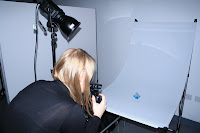We were using
Panchromatic Film which was sensitive
to all light colours.
between the group we used two types of film:
Ill ford FP4 ISO 125
HP5 ISO 400
The roll film has different exposures ranging from 8-16 but this depends on the camera type.
With 6x9 format you will get 8 exposures
With 6x6 you will get 12
With 6x4.5 you will get 16
We are using 120 roll film (you can also get 220)
In the darkroom we took off the film backing paper.
We loaded the non masking tape side onto a spiral.
We were using a twin lens reflex camera (TLR)
(A single lens reflex is what we would normally see (SLR) like our DSLR's)
The top lens is the viewing lens which the light hits the mirror and is projected into the viewfinder.
The bottom lens is the taking lens where the light goes straight from the lens to toe film.
The benefits of this type of camera is that the lens never goes dark so if somebody blinked you would have seen the shot at the exact time it was taken.
Also the photographer looks down into the top of the camera whilst taking the shot.. which means that the person isn't aware they are being photographed which can be a large benefit.
The negatives are that what you see in the viewing lens is slightly different to what the camera captures. they are best for taking mid to long distance photographs and not close ups.
like the camera we used in the first session the aperture and shutter speed are on the lens.
1/300 is the minimum right down to BULB
The aperture ranges from F3.5- F22
For this exersise we used 45º/45º lighting (continuous light)
We used an ambient light meter
There are two types of light we can test
Incident light - direct to subject
Reflective light - off the subject
Our readings were
1/45 F8.0 - indecent
1/15 F8.0 - Reflective reading was 2 stops underexposed
Exposure Latitude for Black ans White film. 2 stops over exposed to 1 1/2 stops under exposed.
We go to 1/8s to be within latitude
Exposure Bracketing - Taking a series of shots of different exposures to graduate a correct one.
the shutter speed is changed for bracketing as there will be no subject movement due to tripod
1/2 s F8.0 -2
1/4 s F8.0 -1
1/8 s F8.0 0
1/15 s F8.0 +1
1/30 s F8.0 +2
When Developing
FP4
Must be 500 ml of each liquid and they must be at 20°
Developer Liquid - 8 mins Agitate for 1 min constant then every 30 seconds for 5 seconds
Stop Bath - 1 min Agitate for 1 min constant
Fixer - 5 mins Agitate for 1 min constant
Water Bath - Leave for a while then hang up to dry









 Iso - 200
Iso - 200 Iso - 200
Iso - 200 Iso - 200
Iso - 200 Iso - 200
Iso - 200 Iso - 200
Iso - 200



















